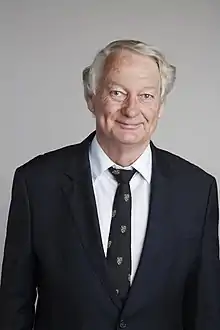John C. H. Spence
John Charles Howorth Spence ForMemRS HonFRMS is Richard Snell Professor of Physics at Arizona State University and Director of Science at the National Science Foundation BioXFEL Science and Technology Center.[3][5][6][7][8][9][10][11]
John Spence | |
|---|---|
 John Spence in 2015, portrait via the Royal Society | |
| Born | John Charles Howorth Spence |
| Alma mater | University of Melbourne (PhD) |
| Awards |
|
| Scientific career | |
| Fields | |
| Institutions | |
| Thesis | Double plasmon studies in several metals (1973) |
| Influences | John Maxwell Cowley[4] |
| Website | |
Education
Spence was educated at the University of Melbourne where he was awarded a PhD in 1973 for work on double plasmon studies of metals.[12][13]
Awards and honours
Spence was elected a Foreign Member of the Royal Society (ForMemRS) in 2015. His nomination reads:[1]
John Spence is distinguished for his innovative world-leading contributions to both biology and materials science. He co-led the team which conceived the first application of X-ray free-electron lasers (XFEL) to structural biology using protein nanocrystals and he pioneered femtosecond serial crystallography. He is also a world leader in the development and application of atomic-resolution electron microscopy and its use for the study of atomic defects in crystals and semiconductors. For example, he co-invented a widely used technique for locating impurity atoms in nanocrystals, for directly and accurately imaging the chemical bonds between atoms, and published the first observation of dislocation kinks, at atomic resolution. He has developed new microscopies and spectroscopies which have given scientists new eyes to understand atomic processes in solids.
In 2017 he was made an Honorary Fellow of the Royal Microscopical Society (HonFRMS) for his contributions to microscopy.[14] Spence is a (corresponding) Fellow of the Australian Academy of Science, and the author of the book "Lightspeed" (OUP 2019) on the history of attempts to measure the speed of light leading to Einstein's theories. For 2021 he was awarded the Gregori Aminoff Prize.[15]
References
- "Professor John Spence ForMemRS". London: The Royal Society. Archived from the original on 2015-05-02.
- Spence, John (2013). High-resolution electron microscopy. Oxford: Oxford University Press. ISBN 978-0-19-966863-2.
- "Regent's Professor J.C.H. Spence". Arizona State University. Archived from the original on 2012-01-30.
- Moodie, A.; Spence, J. C. H. (2006). "John Maxwell Cowley. 18 February 1923 -- 18 May 2004: Elected FRS 1979". Biographical Memoirs of Fellows of the Royal Society. 52: 29–43. doi:10.1098/rsbm.2006.0005.
- John C. H. Spence publications indexed by Google Scholar
- "John Spence, Arizona State University, Department of Physics". bioxfel.org. Archived from the original on 2015-06-06.
- Chapman, H. N.; Fromme, P.; Barty, A.; White, T. A.; Kirian, R. A.; Aquila, A.; Hunter, M. S.; Schulz, J.; Deponte, D. P.; Weierstall, U.; Doak, R. B.; Maia, F. R. N. C.; Martin, A. V.; Schlichting, I.; Lomb, L.; Coppola, N.; Shoeman, R. L.; Epp, S. W.; Hartmann, R.; Rolles, D.; Rudenko, A.; Foucar, L.; Kimmel, N.; Weidenspointner, G.; Holl, P.; Liang, M.; Barthelmess, M.; Caleman, C.; Boutet, S. B.; et al. (2011). "Femtosecond X-ray protein nanocrystallography". Nature. 470 (7332): 73–7. Bibcode:2011Natur.470...73C. doi:10.1038/nature09750. PMC 3429598. PMID 21293373.
- Spence, J. C. H.; Zuo, J. M. (1992). Electron Microdiffraction. doi:10.1007/978-1-4899-2353-0. ISBN 978-1-4899-2355-4. S2CID 45473741.
- Seibert, M. M.; Ekeberg, T.; Maia, F. R. N. C.; Svenda, M.; Andreasson, J.; Jönsson, O.; Odić, D. K.; Iwan, B.; Rocker, A.; Westphal, D.; Hantke, M.; Deponte, D. P.; Barty, A.; Schulz, J.; Gumprecht, L.; Coppola, N.; Aquila, A.; Liang, M.; White, T. A.; Martin, A.; Caleman, C.; Stern, S.; Abergel, C.; Seltzer, V.; Claverie, J. M.; Bostedt, C.; Bozek, J. D.; Boutet, S. B.; Miahnahri, A. A.; et al. (2011). "Single mimivirus particles intercepted and imaged with an X-ray laser". Nature. 470 (7332): 78–81. Bibcode:2011Natur.470...78S. doi:10.1038/nature09748. PMC 4038304. PMID 21293374.
- Laberrigue, A. (1983). "Experimental high-resolution electron microscopyby J. C. H. Spence". Acta Crystallographica Section A. 39 (3): 503–504. doi:10.1107/S0108767383000963.
- Marchesini, S.; He, H.; Chapman, H. N.; Hau-Riege, S. P.; Noy, A.; Howells, M. R.; Weierstall, U.; Spence, J. C. H. (2003). "X-ray image reconstruction from a diffraction pattern alone". Physical Review B. 68 (14): 140101. arXiv:physics/0306174. Bibcode:2003PhRvB..68n0101M. doi:10.1103/PhysRevB.68.140101. S2CID 14224319.
- Spence, John Charles Howorth (1973). Double plasmon studies in several metals (PhD thesis). University of Melbourne. OCLC 224889847.
- Johnson, D. W.; Spence, J. C. H. (1974). "Determination of the single-scattering probability distribution from plural-scattering data". Journal of Physics D: Applied Physics. 7 (6): 771. Bibcode:1974JPhD....7..771J. doi:10.1088/0022-3727/7/6/304.
- "Honourary Fellows". www.rms.org.uk. Retrieved 18 December 2017.
- Gregori Aminoff Prize 2021